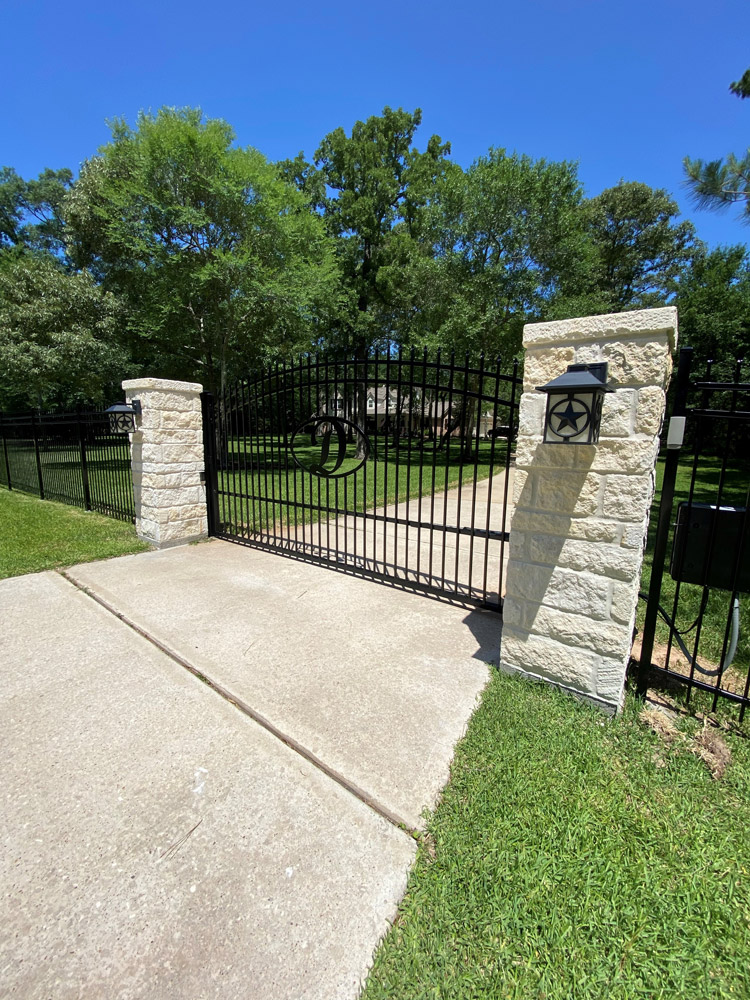Fence Maintenance Tips
Tips to Keep Your Fence Looking Great

It’s a bummer when you look out your backyard, expecting to bask in its beauty and serenity, only to be taken aback by a shabby, worn-out fence. There’s nothing like an ugly fence to take away the magic of the backyard. To ensure that your backyard and fence stay looking fresh, it takes routine maintenance and regular check-ins. After all, taking a couple steps now can save you major trouble down the line. To help keep your fence looking great, we’ve put together a list of fence maintenance tips to help you on your way.
Basic Fence Maintenance Tips
Maintaining your fence is an important and sometimes overlooked aspect of backyard upkeep. With regular inspections, quick and responsible repairs, and a few basic fence maintenance tips, you can keep your fence looking great no matter its age or condition.
When it comes to basic fence maintenance tips, one of the most important rules is to regularly check for any loose boards, nails, split panels, or posts. If problems are caught early on it should be easy to remedy them in a few steps and save yourself the time and money of major repairs down the line. Other rules include not using cleaning products that contain chlorine or other corrosive chemicals which can damage both metal fences and timber fences over time, depending on their make-up. Finally, inspecting for any signs of pests such as insect infestations or rot should also be done regularly so that any issues can be treated at an early stage if necessary.
It’s easy to neglect regular inspection and preventive maintenance when it comes to outdoor structures such as fences, but the benefits certainly outweigh the costs. With basic care, attention, and understanding of what specific materials are required to remain in good shape, you can rest assured that your backyard investment is safe and long-lasting. To make sure this continues to be true, however, it’s crucial that we also make sure to carry out regular inspections and repairs.
Regular Inspections and Repairs
Regular inspections and repairs are key to keeping your fence looking great. Many of these necessary steps can be taken during basic maintenance, however there may be further action required depending on the condition of the fence. Upon inspecting the fence, identify any potential problems such as rotted posts, weakened or rotting boards, or broken clasps. The sooner you address any issue, the better; as this will help to limit more extensive damage in the future that would require extensive repairs.
No matter what type of fencing material you have, it is a good idea to check for signs of rust and corrosion caused by weather and age. Inspections should also be done to verify bolts and screws are tight and locked in place as well as checking for any loose brackets which may be causing sagging or breakage. If any sections appear to have been damaged by animals, insects, or other outside sources, assess how much repair work might need to be done due to the extent of the issue.
Ultimately, regular inspections and repairs can help prevent small issues from turning into costly structural damages requiring extensive labor and materials. By ensuring your fence is properly inspected annually (or earlier if needed) and making minor repairs, when necessary, you can save yourself both time and money in the long run. After taking care of any fill-in jobs needed for your fence’s integrity and aesthetics, cleaning and regular maintenance may be required.
Cleanings and Inspections
Cleaning and inspections are essential aspects of fence maintenance that cannot be overlooked. Regularly cleaning your fence with a garden hose can help remove dirt, grime, and other residue that accumulate over time. Inspecting your fence is just as important as cleaning it. It’s best to inspect your fence on a regular basis for signs of damage, such as cracking, splintering, corrosion, warping, or rot. If you notice any of these issues, repairs should be made immediately as delaying them can lead to bigger problems down the road.
It’s also important to consider the potential for pest infestation when inspecting your fence. Termites and other bugs can cause serious damage to fence if left unchecked. To prevent infestations, it’s recommended to treat your fence with insect repellent or hire a professional pest control service to inspect and treat the perimeter of your property.
The combination of regular cleaning and inspection will ensure your fence remains in great condition for many years to come. While these tips are great for maintaining a standard wooden or metal fence, specialized maintenance may be needed for more unique fencing materials such as bamboo or plastic panels.
Specialized Fence Maintenance Tips
Once you’ve performed regular cleanings and inspections of your fence, there are more specialized tasks that need to be done. Depending on the material of your fence, some things will require different techniques for maintenance. For example, wooden fences may need protection from water damage due to their absorbent nature, while metal or brick fences may need paint jobs to reduce weathering and discoloration over time. Regardless of the material, one thing applies to all types of fences: they require occasional maintenance beyond the basics in order to ensure they look great over time.
For wooden fences, it’s essential to apply sealants or stains every two to three years. Doing so protects against water damage, bugs, mildew, and other potential hazards that can compromise the aesthetic or decrease its longevity. Metal fences should similarly be inspected often for corrosion and painted when necessary. Some people debate if it’s necessary to paint metal fences since rust can still occur regardless; however, experts agree that a coat of paint is the best way to prevent oxidization since it prevents water from coming into contact with the metal underneath. Brick fences are generally low-maintenance but can still benefit from a coat of sealant over time depending on the climate you live in.
If these special maintenance tasks seem too cumbersome for you, hiring an experienced professional can not only save you time but also ensure that your fence receives the care it needs for optimal performance and longevity.
With careful maintenance over time and an eye for what specific needs arise based on its particular material, you can easily keep your fence looking great into the future.
Aluminum vs Wood Fences
When considering the best type of fence for your home, aluminum, and wood both offer distinct advantages that can make them ideal options. Aluminum is more affordable, lasts longer, and requires more minimal maintenance while wooden fences provide a more classic and traditional look; giving you the opportunity to match your outdoor decor with ease. Ultimately, each material offers its own set of benefits and drawbacks that must be weighed for the most suitable decision for you and your needs to be made.
Aluminum fences are renowned for their durability due to their corrosion-resistant nature which allows them to last much longer than traditional wooden fences. They also require less effort to maintain with regular cleaning using a power washer or simple garden hose effective enough. However, some homeowners may find this option too industrial looking, but if a more stylized design is desired, they do come in various colors and textures including powder coating. Additionally, aluminum fences are relatively low cost compared to other materials making them a great economical choice.
Wooden fences on the other hand provide a better aesthetic value and presents the homeowner with unbeatable natural beauty of wood grain and warm colors. Wood has been used forever in fencing, making it an old school classic – something some homeowners cannot sacrifice when seeking elegance and charm. However, these traditional installations come with more maintenance demands due to their susceptibility to rotting and warping from water damage as well as needing regular sanding, staining, or refinishing every few years in order to retain its original allure. This makes wood more expensive in terms of upkeep costs over time despite being initially cheaper than aluminum.
Deciding between aluminum vs wood fences is up to personal preference so you must take into consideration your budget constraints as well as what aesthetic appeal you desire when selecting one or the other – or if you want something else entirely like vinyl or composite materials! No matter what option you decide upon, it’s important that proper care and maintenance be performed throughout the life of your fence in order to ensure optimal performance and lifespan longevity.
Important Considerations for Fence Maintenance
When deciding between an aluminum or wood fence, there are important considerations to make regarding maintenance. The material chosen should be able to withstand the elements of the environment it resides in and be strong enough for its intended purpose. Aluminum is generally a lower maintenance choice, as it does not need painting or staining and can withstand most weather conditions. Additionally, aluminum fences often come with a guarantee from the manufacturer, ensuring that you will get a good quality product that stands up over time. However, some homeowners may prefer the look of wood and may be willing to put in the extra effort to keep their fences looking good. Wood can provide a classic look and feel to your yard but requires regular refinishing to maintain its aesthetic value. Additionally, certain woods may require more frequent care than other types. While aluminum is relatively low-maintenance, and good quality wooden fences are built to last, both should be inspected regularly for signs of wear and tear over time.
Regardless of the material you choose, it’s important to consider your local soil conditions, as these can have a strong influence on how easily fence posts are installed or remain stable in windy conditions. Weather conditions such as heavy rain or winds should also play a key role in determining how durable your fence will be once constructed. Taking into account all of these factors will help you make an informed decision regarding which type of fence best suits your property’s needs and ensure a long lifespan for your new investment. With proper care and consideration taken in choosing materials and understanding local conditions, any homeowner can enjoy the aesthetic benefits associated with fences for many years to come. As you tackle this project, take note of the various soil conditions and weather patterns that could affect your fencing materials over time as you move onto considering them for your fencing project.
Soil Conditions and Weather Conditions
Once you’ve examined the materials of your fence, it’s time to consider additional factors, such as soil and weather conditions. Fences are particularly vulnerable to moisture and temperature changes, so it’s important to be aware of the environment in which your fence resides. Depending on these conditions, our simply caring for your fence may not be enough; additional measures may need to be taken to ensure its longevity.
Of course, the type of soil surrounding your fence also plays a role in its maintenance. Clay-based soils retain moisture longer than sandy soils, meaning they could cause long-term damage if left unattended. Sandy soils, while they don’t create as much immediate harm to a fence, could cause subtle wear over time due to settling and shifting of the dirt around the posts. In either case, keeping an eye on local levels of precipitation can help you gauge whether there is any potential threat of too much moisture in the ground.
It is important not just to monitor the moisture content, but also extreme temperatures changes seen throughout the year. While some materials fare better in higher temperatures, others like composite panels tend to become brittle during colder temperatures and can snap more easily if exposed to consistent cold weather over an extended period.
Be aware and be proactive in inspecting your fence to keep ahead of any potential damages that may occur and take swift action to properly protect your investment. Taking simple steps like sealing wood every couple of years or painting metal poles every decade can save you thousands down the line by ensuring your fence remains structurally sound and attractive for years come.
Keeping Rust at Bay
When it comes to maintaining your fence, one of the most important elements to consider is rust prevention. Rust can cause significant damage to the structure of a fence if not properly addressed. Fortunately, taking a few simple steps can help keep rust at bay and protect the integrity of your fence.
The first step in preventing rust is to keep your fence clean and free of moisture. Moisture provides an optimal environment for rust to grow, so minimizing or eliminating standing water or snow around the fence will go a long way in reducing the chances of rust forming and spreading. This can be done by removing leaves and debris from around the base of your fence, as well as using gutters or other drainage systems to redirect runoff away from your yard.
Secondly, it’s vital that you regularly inspect your fence for signs of rust, even if you take preventative steps. Checking for any corrosion on both the interior and exterior portions of the fence will allow you to spot issues quickly and address them before they become a major problem. If rust spots are found, they should be sanded down and treated with a corrosion resistant coating on both sides to ensure that all areas are properly protected from further rusting.
Finally, selecting a metal that is more likely to resist corrosion when constructing your fence is equally important. While steel fences typically retain their durable and clean appearance for many years without requiring much maintenance, aluminum has been proven to be superior in terms of its resistance against oxidation. Furthermore, stainless steel cannot be affected by salt, making it a great choice for coastal locations where exposure to saltwater is common.
Overall, taking these preventative measures can help keep rust from developing on your fence in the first place. With proper maintenance and attention to detail, you can ensure your fence remains in tip-top shape while still looking brand new year after year!
Frequently Asked Questions
What are some tips for extending the life of a fence?
1. Regular inspection and maintenance: Inspect your fence at least twice a year, paying attention to the condition of the posts and boards. Any loose or rotten boards should be replaced immediately, and any nails should be tightened or replaced. This can help prolong the life of your fence by preventing water from seeping into the posts and weakening them.
2. Staining/painting/sealing: To protect your fence from the elements, it is important to apply a quality wood sealant or stain every two to three years. This will help keep moisture out of the wood, keeping it strong and resistant to rot.
3. Support posts: Make sure the support posts for your fence are well-anchored in concrete, with proper drainage away from them to keep them dry. If your support posts start to rot due to standing water in their base, then replacing them is essential to extending the life of your fence.
4. Proper care when cleaning: When you clean your fence (such as when pressure washing), take care not to apply too much pressure that could damage the boards or posts. Be sure to direct the nozzle up towards the top of each board, not down between them where the pressure will be greater.
5. Focus on longevity over aesthetics: Although features such as latticework can add aesthetic appeal to your fence, they offer little practical use and may need more frequent replacement to extend the life of your fence overall. Consider opting for plain but durable components that can withstand tough weather conditions without fail.
What are some of the most common problems with fences?
One of the most common problems with fences is poor maintenance. If a fence isn’t regularly cleaned with warm soapy water and inspected for signs of wear and decay, it can become an eyesore that detracts from your home’s overall aesthetic.
Another common problem with fences is inadequate support structures. Even the sturdiest of fences require strong posts to remain upright and secure in place. Most posts are made from metal or wood, both of which will deteriorate over time if not properly maintained or replaced.
Additionally, common weather events such as high winds and heavy rains can cause damage to fences that weren’t properly installed or have weak points along their length. This can lead to uprooted fence panels, posts, and rails that need to be repaired or replaced to maintain its protective function.
Finally, pests such as termites can wreak havoc on wooden fences if left unchecked. Termites can quickly weaken even the strongest of wood fence materials if they are able to gain access to the post and rail joints. Regular inspections are essential to detect these potentially devastating pests before they do too much damage.
What type of maintenance should be done to a fence on a regular basis?
Regular fence maintenance is key to keeping your fence looking great and lasting through the years. Depending on the materials used, there are a few different types of maintenance that should be done to keep your fence looking its best.
For wooden fences, regular staining or painting is necessary to maintain the color and integrity of the wood. These treatments help it hold up against moisture and wear and will prevent rot over time. In addition, you should make sure to inspect the structural integrity of the wood every year, tightening any loose boards, replacing any rotten wood, and securing all bolts and screws.
Chain link fencing does not require much upkeep, but you should make sure to inspect it for wear and tear annually. This can include checking for rust spots, damaged poles/posts, bent wires or links, weak connections, broken locks, or hinges, etc. You may also want to spray it down with water occasionally in order to clean off dirt and debris buildup.
Vinyl fences are incredibly low maintenance as they don’t require any staining or painting. However, they still need inspection for signs of damage from water exposure or environmental factors like extreme heat or cold weather. Check for warping or improper installation of slats or posts on a regular basis as well.
By following these simple tips for regularly maintaining your fence, you can ensure that your fence looks great for years to come!








